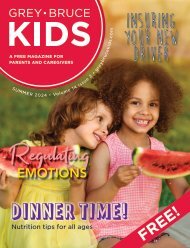Grey Bruce Kids Fall 2021
You also want an ePaper? Increase the reach of your titles
YUMPU automatically turns print PDFs into web optimized ePapers that Google loves.
The parent-child relationship is a complex and unique bond<br />
which every child and parent will experience.<br />
For some, this bond forms instantaneously, while for others it<br />
takes time to flourish. Regardless, its influence on the child’s<br />
personality, life choices, and behaviour create the foundation for<br />
which the child develops emotionally, physically, and socially.<br />
Much like adults, children express and experience love in<br />
different ways. This can bring an additional layer of strain and<br />
challenge into the already difficult responsibility of parenting.<br />
Speaking our child’s ‘love language’ helps them to understand<br />
what it means to be loved unconditionally. Until we take a<br />
moment to pause, to begin to truly understand our children’s<br />
individual love languages, we are only speaking our love to our<br />
child, and they won’t be able to feel it.<br />
Gary Chapman and Dr. Ross Campbell introduced the concept<br />
of love languages in the book The Five Love Languages of<br />
Children. They explain that, like adults, children feel love<br />
through physical touch, words of affirmation, acts of service,<br />
gifts, and quality time.<br />
Love language combinations are individual to each child. And<br />
yes, when navigating love languages within a family unit may<br />
be challenging; however, if you focus on the five basic love<br />
languages, it will make an enormous difference in your child’s<br />
sense of being loved.<br />
Five love<br />
languages<br />
PHYSICAL TOUCH<br />
For a child who craves the love language of physical touch, you<br />
may notice them constantly climbing on your lap, asking for<br />
tickle fights or wanting to roughhouse. For most children this<br />
is their primary love language. The presence of physical touch<br />
communicates love to them, even more than praise or gifts.<br />
The key to the language of physical touch is touch beyond the<br />
necessary. Without little pats on the back, a ruffling of their<br />
hair, hugs or kisses, their “love tank” will remain less than full.<br />
The gift of physical touch may become more difficult to give<br />
as children grow into tweens and teens. Depending on their<br />
emotional security, parents may hold back from giving this out<br />
of fear of lashback. Many teens may be resistant to affectionate<br />
touch; however, they still require physical touch as an<br />
affirmation of love. Teen boys are more accepting of a rougher,<br />
more abrasive touch such as wrestling, playfulness, bear hugs,<br />
or high fives. Girls too are open to this type of touch but also<br />
respond to a gentler, more compassionate touch such as a longer<br />
hug.<br />
Expressions of physical touch to<br />
express love include:<br />
• Giving lots of hugs and kisses, letting a smaller child sit on<br />
your lap<br />
• Snuggles<br />
• Spinning round and round<br />
• Reading a book together<br />
• Wrestling, tickle fights<br />
• A playful elbow and smile as you walk by<br />
• Creating a spa night and giving pedicures and manicures to<br />
each other<br />
• High fives or affectionate pats on the back<br />
• Tousling their hair<br />
greybrucekids.com • 5

















